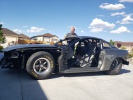Has anyone played with the cam tables yet? Tried adjusting them, but wasn't able to get any conclusive results. Looks like the cams start at zero when key on engine off, are a 23 degrees intake 9 degrees exhaust at idle and run 13-14 degrees each at peak torque.
Are the cams actuators advance or retard only? Is there an easy way to tell?
Will post a stock file in a bit....




 Reply With Quote
Reply With Quote
